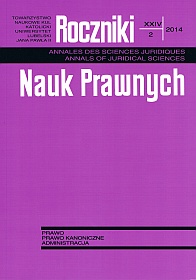The character of EU law legislation in the practice of Court of Justice and member state constitutional tribunals
Abstract
The purpose of this paper is to show a dependency between the opinions of the Court of Justice and the constitutional courts of the member states with regard to the definition of the basic principles of the EU law. The subject of the discussion focuses on only one principle – supremacy of the EU legislation, which is the most problematic issue. The scope of the discussion refers to opinions of constitutional courts, which are the most relevant for our study. The paper is divided into three chronological parts.
The first part refers to the beginnings of the European Union, where cooperation between the member states focused on economic issues. Here, a reference is made to the opinions of the Federal Constitutional Court and Italian Constitutional Court.
The second part also deals with economic cooperation, but the dialogue between the Court of Justice and constitutional tribunals becomes distinct in its character. Here, the first difference of opinion is demonstrated. Realising their competences, the European Communities take into consideration the rights and freedoms of individuals, fundamental rights protected by the constitutions of the member states. In this part, the adoption of a compromise between the Court of Justice and constitutional courts is presented.
The third part concerns the creation of the EU, and thus the extension of its powers into new areas, which until 1992 were the domain of nation-states. In this context, there arises the problem of the scope of competence as well as the relationship between constitutions and the EU law. This part also considers the rulings of the Polish Constitutional Tribunal on the principle of supremacy to show the attitude of the newly accepted states towards the EU. Thus, the Author makes a reference to the judicature of the Federal Constitutional Court and the Polish Constitutional Tribunal.
The considerations in this paper prove that despite differences regarding the interpretation and origin of the supremacy rule, constitutional courts and the Court of Justice seek to find an area of cooperation. Constitutional Courts do not suppress the jurisdiction of the Court of Justice but only indicate the limits of its juridical freedom. Whereas the Court of Justice accepts the cultural and systemic diversity of the member states, it interprets the EU law respecting the former.
References
Arnold R.: Orzecznictwo niemieckiego Federalnego Trybunału Konstytucyjnego a proces integracji europejskiej, „Studia Europejskie” 1 (1999), s. 95-107.
Barcz J.: Główne reformy strukturalne ustroju Unii Europejskiej, [w:] Traktat z Lizbony. Główne reformy ustrojowe Unii Europejskiej, red. J. Barcz, Warszawa 2008, s. 53-97.
Barcz J.: Wybrane problemy związane z wyrokiem niemieckiego Federalnego Trybunału Konstytucyjnego z 30.06.2009 r. na temat zgodności Traktatu z Lizbony z Ustawą Zasadniczą RFN, „Europejski Przegląd Sądowy” 9 (2009), s. 13-25.
Banaszak B.: Prawo polskie a prawo Unii Europejskiej w orzecznictwie Trybunału Konstytucyjnego, „Europejski Przegląd Sądowy” 12 (2012), s. 49-69.
Banaszkiewicz B.: Węzłowe problemy w orzecznictwie Trybunału Sprawiedliwości Wspólnot Europejskich, Biuro Trybunału Konstytucyjnego, Zespół orzecznictwa i studiów, 2003, http://www.trybunal.gov.pl/epublikacje/download/Trybunal_sprawiedliwosci.pdf [dostęp: 5.09.2014].
Biernat S.: Prawo Unii Europejskiej a Konstytucja RP i prawo polskie – kilka refleksji, „Państwo i Prawo” 11 (2004), s. 18-27.
Biernat S.: Zasada pierwszeństwa prawa unijnego po Traktacie z Lizbony, „Gdańskie Studia Prawnicze” 25 (2011), s. 47-61.
Dobrowolski M.: Glosa do wyroku Trybunału Konstytucyjnego z dnia 11 maja 2005 r. (sygn. akt K 18/04) [dot. hierarchii norm prawa wspólnotowego i Konstytucji], „Zeszyty Naukowe NSA” 3 (2006), s. 145-160.
Dobrowolski M.: Konstytucyjność Traktatu akcesyjnego w świetle orzeczeń trybunału Konstytucyjnego dotyczących europejskiego nakazu aresztowania, „Przegląd Sejmowy” 6 (2006), s. 73-88.
Dobrowolski M.: Podstawowe zasady ustrojowe w europejskich orzeczeniach Trybunału Konstytucyjnego, „Przegląd Sejmowy” 1 (2007), s. 9-20.
Justyńska P.: Między supremacją a pierwszeństwem prawa unijnego. Jedność w różno-rodności, [w:] Unia Europejska: zjednoczeni w różnorodności, red. C. Mik, Warszawa 2012, s. 111-147.
Kalisz A.: Multicentryczność systemu prawa polskiego a działalność Europejskiego Trybunału Sprawiedliwości i Europejskiego Trybunału Praw Człowieka, „Ruch Prawniczy, Ekonomiczny i Socjologiczny” 69 (2007), z. 4, s. 35-49.
Koncewicz T.T.: Zasada kompetencji powierzonej Trybunału Sprawiedliwości Wspólnot Europejskich, Warszawa 2009.
Koncewicz T.T.: Trybunał Konstytucyjny wobec prawa europejskiego, cz. I, „Przegląd Sejmowy” 2 (109) 2012, s. 105-134.
Koncewicz T.T.: Trybunał Konstytucyjny wobec prawa europejskiego, cz. II „Przegląd Sejmowy” 3 (110) 2012, s. 125-160.
Kumm M.: Who is the final arbiter of constitutionality in Europe? Three conceptions of relationship between German Federal Constitutional Cour and the European Court of Justice, „Common Market Law Review” 36 (1999), s. 351-386.
Kutra A.: Kolizje norm konstytucyjnych i wspólnotowych w ujęciu teoretyczno-prawnym, „Europejski Przegląd Sądowy” 5 (2007), s. 23-31.
Krzysztofik E.: Ewolucja wspólnotowego systemu ochrony praw człowieka, „Studia Prawnicze KUL” 2 (34) 2008, s. 33-50.
Krzysztofik E.: Poszanowanie wartości narodowych przesłanką uzasadniającą ograniczenie swobód rynku wewnętrznego, [w:] Unia Europejska: zjednoczeni w różno-rodności, red. C. Mik, Warszawa 2012, s. 437-452.
Łętowska E.: Multicentryczność współczesnego systemu prawa i jej konsekwencje, „Państwo i Prawo” 4 (2005), s. 3-10.
Mikłasiewicz P.: Zasada pierwszeństwa w krajowych porządkach prawnych według orzecznictwa ETS i Sądu I Instancji, Biuro Trybunału Konstytucyjnego, Zespół orzecznictwa i studiów, 2005, http://www.trybunal.gov.pl/epublikacje/download/PIERWSZENSTWO.pdf [dostęp: 5.09.2014].
Pal R.M.: Charakter prawa Unii Europejskiej, [w:] Prawo instytucjonalne Unii Europej-skiej w zarysie, red. A. Kuś, Lublin 2012, s. 303-343.
Pawłowski S.: Zjednoczeni w różnorodności – perspektywa Federalnego Trybunału Konstytucyjnego, [w:] Unia Europejska: zjednoczeni w różnorodności, red. C. Mik, Warszawa 2012, s. 147-179.
Rainer A.: Orzecznictwo niemieckiego Federalnego Trybunału Konstytucyjnego a pro-ces integracji europejskiej, „Studia Europejskie” 1 (1999), s. 95-107.
Sieniow T.: Geneza i rozwój procesów integracyjnych w Europie po II wojnie światowej, [w:] Prawo instytucjonalne Unii Europejskiej w zarysie, red. A. Kuś, Lublin 2012, s. 25-71.
Winczorek P.: Konstytucja RP a prawo wspólnotowe, „Państwo i Prawo” 11 (2004), s. 3-17.
Witkowski Z.: Ustrój konstytucyjny współczesnych Włoch w aktualnej fazie jego przemian 1989-2004, Toruń 2004.
Copyright (c) 2014 Roczniki Nauk Prawnych

This work is licensed under a Creative Commons Attribution-NonCommercial-NoDerivatives 4.0 International License.


